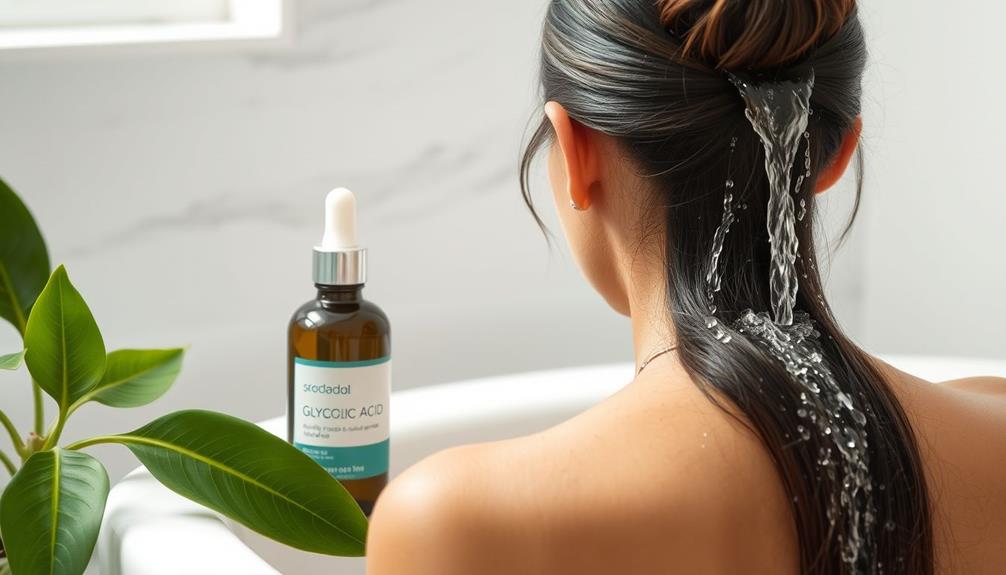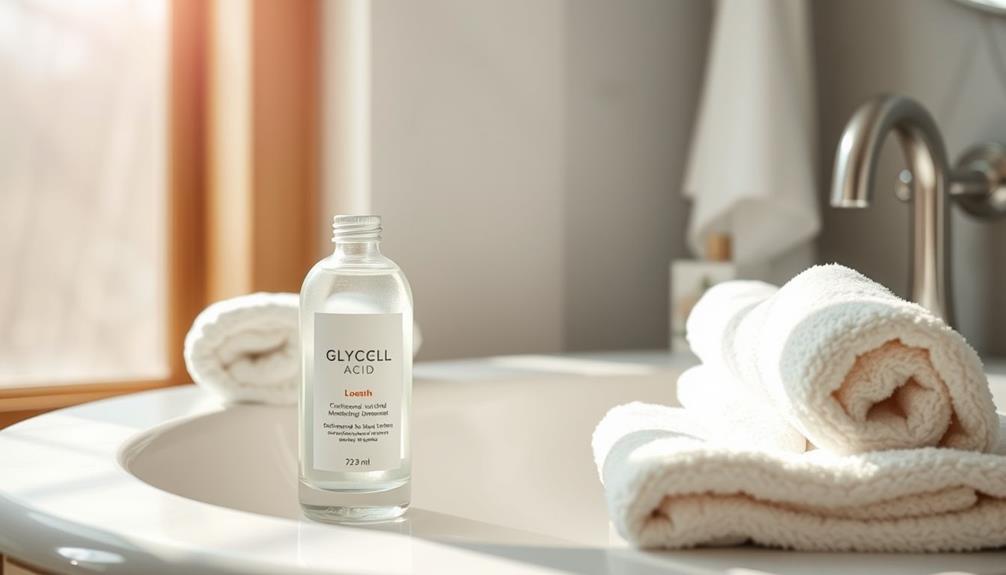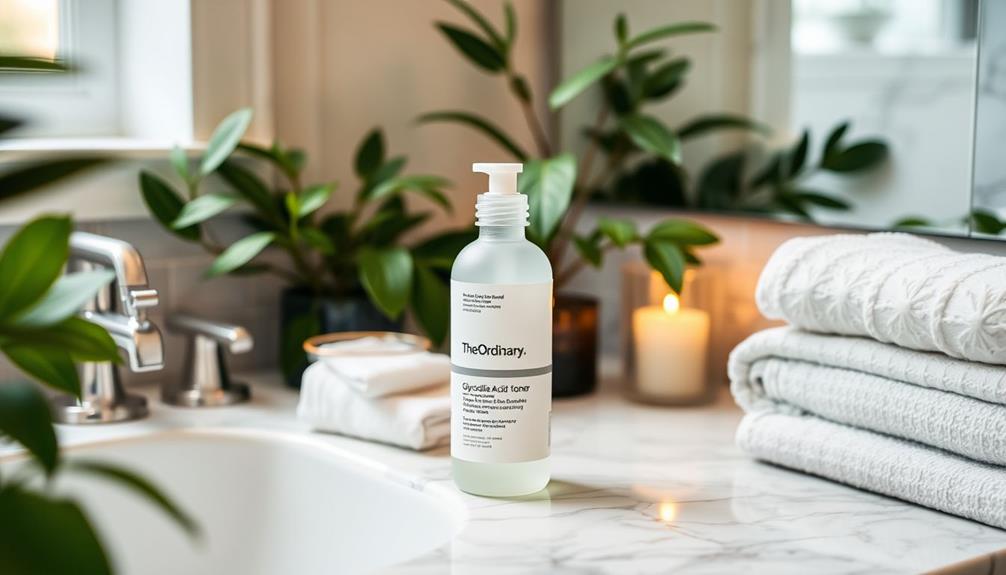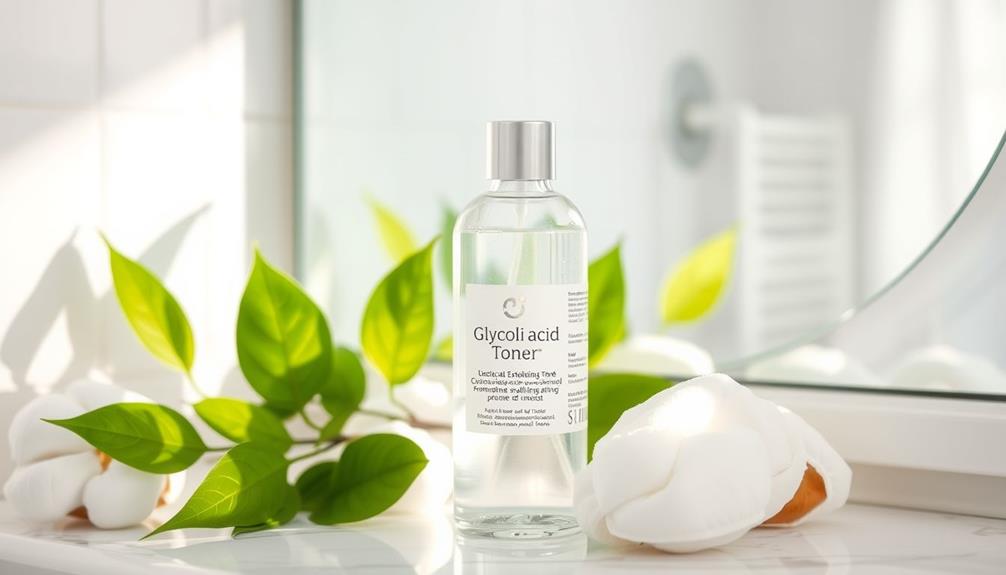Glycolic acid is becoming increasingly popular for scalp health because it effectively exfoliates and hydrates, promoting hair growth and scalp wellness. By breaking down dead skin cell bonds, it clears buildup and unclogs hair follicles, leaving your scalp feeling cleaner. Additionally, it improves blood circulation and helps retain moisture, effectively combating dryness and irritation. Ideal for all skin types, it is particularly beneficial for those with sensitive scalps. Adding glycolic acid to your routine can revolutionize your hair care routine, leading to visible improvements. There is much more to learn about how this powerful ingredient can enhance your scalp care routine.
Key Takeaways
- Glycolic acid effectively exfoliates the scalp, removing dead skin cells and preventing clogged hair follicles, promoting healthier hair growth.
- It enhances scalp hydration by acting as a moisture magnet, balancing pH levels for optimal follicle health.
- Regular use of glycolic acid improves blood circulation, nourishing hair follicles and enhancing overall scalp vitality.
- Suitable for all skin types, it helps manage both oily and dry scalps, restoring moisture without irritation.
What Is Glycolic Acid?

Glycolic acid, an alpha-hydroxy acid derived from sugar cane, stands out as the smallest AHA, making it effective at penetrating deeper into your skin and scalp. This unique property allows glycolic acid to work wonders when it comes to exfoliating.
By dissolving the bonds between dead skin cells, it promotes their easy removal, enhancing your scalp health and leaving you with a smoother texture. Incorporating essential oils, such as lavender and rosemary, can further support scalp health by promoting follicle stimulation and improving circulation essential oils for hair growth.
Incorporating glycolic acid into your scalp treatments can help combat product buildup and excess sebum. This can be particularly beneficial if you've noticed dullness or flakiness in your scalp.
As glycolic acid works to unclog hair follicles, it also boosts hydration levels, ensuring your scalp feels refreshed and revitalized.
One of the great things about glycolic acid is its versatility; it's suitable for all skin types, including sensitive skin. However, you should be cautious with higher concentrations to avoid irritation.
Benefits for Scalp Health

Glycolic acid offers significant benefits for your scalp health by effectively exfoliating and removing buildup.
This powerful ingredient enhances hydration levels, creating a more balanced environment that supports hair growth.
Additionally, using glycolic acid can help alleviate dryness and flakiness, promoting a healthier scalp overall.
By incorporating glycolic acid into your routine, you can enjoy a cleaner, healthier scalp.
For further tips on maintaining scalp health, check out these yoga poses for back pain relief.
Exfoliation and Buildup Removal
Exfoliating the scalp with glycolic acid helps break down dead skin cell bonds, promoting a cleaner and healthier environment for your hair. This powerful chemical exfoliant effectively removes product buildup, excess sebum, and dead skin flakes, enhancing your scalp health.
Regular use can lead to several benefits:
- Prevents clogged hair follicles: Keeping follicles clear supports hair growth and reduces hair loss.
- Promotes cell turnover: Regular exfoliation helps your scalp shed old skin, allowing new, healthy cells to thrive, similar to how essential oils can enhance skin quality and health through their <a target="_blank" href="https://aromatherapynaturals.com">topical application</a>.
- Nourishes hair follicles: Improved blood circulation helps deliver essential nutrients to your hair roots.
- Reduces dryness and irritation: Regular use alleviates the discomfort linked with dead skin accumulation.
Incorporating glycolic acid into your hair care routine can greatly boost your scalp's health. Embracing this exfoliation method not only removes buildup but also lays the foundation for vibrant, healthy hair.
Enhanced Scalp Hydration
Enhancing scalp hydration is vital for maintaining a healthy environment that supports hair growth and prevents dryness. Glycolic acid plays a significant role in achieving this goal. It acts as a moisture magnet, attracting and retaining water in the scalp. By stimulating the production of hyaluronic acid, glycolic acid helps maintain ideal moisture levels, which is essential for preventing dryness.
| Benefit | Description |
|---|---|
| Scalp Hydration | Glycolic acid enhances moisture levels in the scalp. |
| Improved Scalp Texture | Regular use leads to smoother, healthier scalp skin. |
| Dandruff Treatment | Alleviates dandruff, promoting a healthier scalp. |
With its exfoliating properties, glycolic acid balances the scalp's pH levels, creating an optimal environment for hair follicles. This not only supports hair growth but also improves overall scalp texture, ensuring your scalp remains healthy. By incorporating glycolic acid into your routine, you can effectively enhance scalp hydration, support hair growth, and prevent dryness, leading to a healthier scalp overall.
How Glycolic Acid Works

By penetrating deeply into the scalp, glycolic acid effectively dissolves the bonds between dead skin cells, making it easier to remove them. This powerful exfoliation process helps you achieve healthier scalp conditions, allowing for better hair growth.
As noted in ancient wisdom, the importance of maintaining a balanced environment is essential for overall well-being. Here's how glycolic acid contributes to scalp health:
- Removes dead skin cells: It targets dead skin buildup, clearing away impurities.
- Reduces excess oil: By balancing oil production, it prevents greasy hair and scalp issues.
- Eliminates product residue: It cleanses away leftover products, ensuring your scalp feels refreshed.
- Enhances hydration levels: Acting as a moisture magnet, glycolic acid helps retain moisture and balance pH levels.
Moreover, glycolic acid also boasts antibacterial properties that help reduce scalp acne and irritation, further promoting a cleaner and healthier scalp environment.
Incorporating glycolic acid into your scalp care routine can lead to noticeable improvements in both scalp health and hair health. It's a straightforward approach to maintaining a balanced and nourished scalp, ensuring your hair looks its best.
Using Glycolic Acid Safely

When using glycolic acid, you should always start with a patch test to check for any sensitivity before applying it to your scalp.
This is particularly important if you have curly hair, as certain hair products can exacerbate irritation.
It's best to limit your applications to once or twice a week to prevent irritation.
By following these guidelines, you can enjoy the benefits of glycolic acid while keeping your scalp healthy and safe.
Additionally, consider consulting with professionals to determine the best approach for your specific hair type, as consultations recommended to discuss desired looks can provide personalized insights.
Patch Testing Importance
Patch testing glycolic acid is necessary to confirm your scalp can tolerate it without experiencing irritation or adverse reactions. This step is especially important if you have a sensitive scalp or existing skin conditions.
Understanding how your skin responds to various products is significant, as cat health and nutrition can be similarly affected by new treatments.
Here's how to effectively conduct a patch test:
- Apply a small amount of glycolic acid to a discreet area, like behind your ear or on your inner arm.
- Observe the patch for 24-48 hours to check for any signs of irritation or discomfort.
- If you notice redness, itching, or any adverse reactions, stop using the product immediately.
- Consult a dermatologist for personalized advice if you experience any issues.
Regular patch testing is essential when introducing new glycolic acid products, as formulations can vary, and your skin sensitivity may change over time.
This precaution helps confirm that you can safely enjoy the benefits of glycolic acid for scalp health without compromising your skin's well-being.
Recommended Application Frequency
Using glycolic acid on your scalp once or twice a week can help you avoid irritation while promoting ideal scalp health. It's essential to consult a dermatologist, especially if you have sensitive skin or are using other hair treatments. Start with lower concentrations, around 5-7%, to assess your tolerance before moving to higher levels.
Here's a quick guide to help you determine your application frequency:
| Type | Frequency | Notes |
|---|---|---|
| Normal Skin | Once a week | Monitor for irritation. |
| Sensitive Skin | Every two weeks | Consider patch testing first. |
| Higher Concentrations | Once every two weeks | Start with lower concentrations initially. |
| Long-term Use | Limit to 1-2 times/month | Prevent adverse effects. |
| After Sun Exposure | Avoid using for 48 hours | Protect your scalp from irritation. |
Remember to avoid sun exposure after applying glycolic acid, as it increases skin sensitivity, leading to potential sunburn. With careful application, you can enjoy the benefits of this effective chemical exfoliant while maintaining a healthy scalp.
Alternatives for Scalp Care

Exploring alternatives for scalp care can lead you to effective solutions that nourish and maintain scalp health without the irritation sometimes caused by glycolic acid. Here are some natural alternatives that can help with gentle exfoliation and balancing excess oils:
- Lactic acid: A milder AHA that provides effective exfoliation and hydration, making it perfect for sensitive scalps.
- Apple cider vinegar: Known for its natural cleansing properties, it helps balance scalp pH and reduces flakes without harsh chemicals.
- Tea tree oil: This antimicrobial option combats scalp acne and soothes irritation, making it suitable for oily or problematic scalps.
- Salicylic acid: Designed for oily scalps, it targets excess sebum and impurities, offering a deeper cleanse than glycolic acid.
Expected Results From Treatments
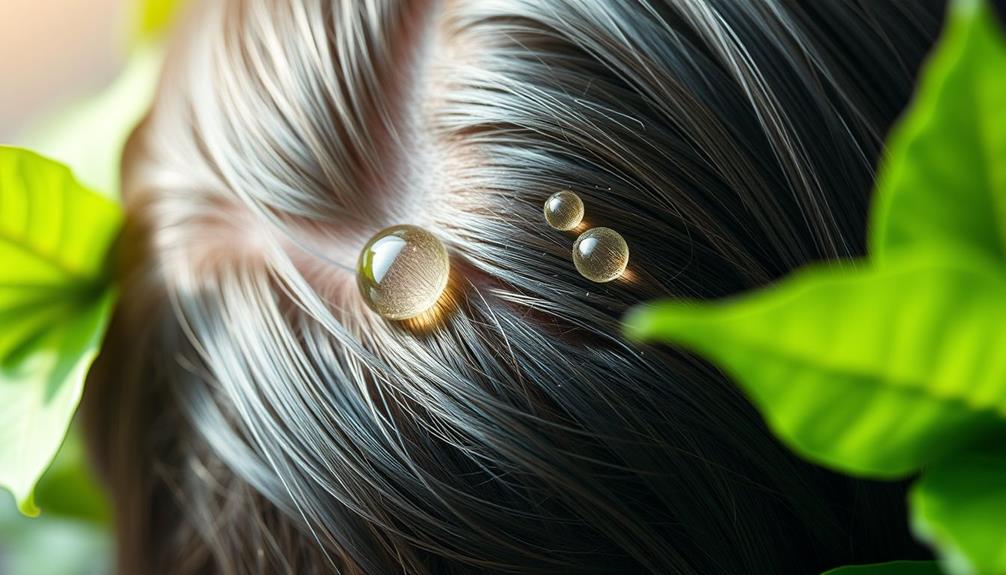
When considering glycolic acid for scalp care, you can expect marked improvements in scalp health and overall hair quality with regular treatments.
Glycolic acid effectively exfoliates your scalp, reducing product buildup and excess oiliness that can hinder healthy hair growth. As you incorporate this treatment into your routine, you may notice enhanced blood circulation in your scalp, promoting healthier hair growth and better nourishment for your hair follicles.
Many users report improved hydration levels, especially beneficial for those with dry scalps, helping restore moisture balance. This increased hydration not only makes your scalp feel more comfortable but also aids in alleviating dandruff and flakiness, leading to a cleaner scalp environment.
With consistent use, you can expect smoother hair texture as glycolic acid unclogs pores and allows for better hair quality and shine. These results make glycolic acid a powerful ally in your scalp care regimen.
Common Concerns and Misconceptions

Many people hold misconceptions about glycolic acid, believing it's only beneficial for facial skin rather than recognizing its advantages for scalp health. This powerful exfoliant can do wonders for your scalp, helping you address various issues you may face.
Here are some common concerns and misconceptions:
- Glycolic acid is only for oily scalps; it actually benefits dry scalp by restoring moisture balance.
- It causes scalp irritation; however, using moderate concentrations (5-10%) safely is key.
- It strips hair color; low concentrations manage product buildup without damaging color-treated hair.
- Glycolic acid is too harsh for sensitive skin; patch testing can help you find the right level.
Incorporating Glycolic Acid Into Routine

Incorporating glycolic acid into your scalp care routine can elevate your scalp health by effectively exfoliating and rejuvenating the skin.
To start, look for products with glycolic acid concentrations between 5% to 10%. These levels are ideal for regular exfoliation, helping to remove dead skin cells and product buildup without causing irritation.
Begin by applying glycolic acid treatments once a week, allowing your scalp to adjust and minimizing potential dryness or sensitivity. If you have an oilier scalp, you might tolerate stronger formulations better, but it's wise to start slowly with lower concentrations.
After exfoliating, always follow up with a hydrating conditioner or scalp serum. This step is essential as it restores moisture balance, enhancing the benefits of your treatment.
Regular use of glycolic acid can lead to a healthier scalp, promoting hair growth and improving overall hair texture.
By keeping your scalp free from dead skin cells and product buildup, you create a more conducive environment for healthy hair development.
Frequently Asked Questions
Why Use Glycolic Acid on Scalp?
You should use glycolic acid on your scalp because it exfoliates dead skin, enhances blood circulation, retains moisture, balances pH, and penetrates deeply, all contributing to healthier hair growth and a more balanced scalp environment.
Does Glycolic Acid Cause Hair Thinning?
You might think glycolic acid's a hair villain, but it's not! Used correctly, it won't cause hair thinning; just be cautious, or you could irritate your scalp and create an unhealthy environment for growth.
Why Is Glycolic Acid so Good?
Glycolic acid's great because it exfoliates dead skin, boosts hydration, and enhances blood circulation. You'll notice reduced flakiness and irritation, leading to a healthier scalp and potentially stronger, shinier hair with regular use.
Is Salicylic Acid or Glycolic Acid Better for Scalp?
It depends on your scalp needs. If you're dealing with excess oil and clogged pores, salicylic acid's your best bet. For dry, flaky issues, glycolic acid will enhance texture and hydration effectively.
Conclusion
Glycolic acid can transform your scalp health, turning dryness and irritation into a soothing, revitalized experience.
Imagine the relief of a nourished scalp after battling itchiness and flakiness for too long.
As you incorporate this powerful ingredient into your routine, you're not just treating your scalp; you're reclaiming your confidence.
Embrace the journey from discomfort to comfort, and let glycolic acid be your ally in achieving a healthier, happier scalp.
Your hair deserves it!

